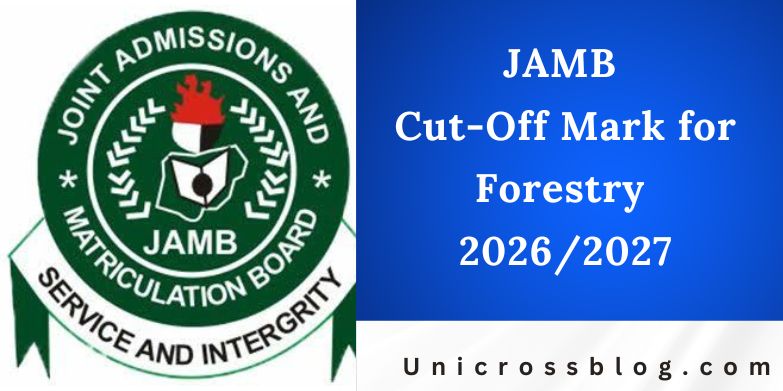The Joint Admissions and Matriculation Board (JAMB) plays a pivotal role in shaping the educational landscape of Nigeria by conducting the Unified Tertiary Matriculation Examination (UTME). This examination serves as the gateway for millions of aspiring students seeking entry into universities, polytechnics, and colleges of education each year. For the 2026/2027 academic session, JAMB’s cut-off marks represent the minimum scores required for candidates to qualify for post-UTME screenings and subsequent admissions. These marks are not arbitrary; they are determined annually during JAMB’s policy meeting, where stakeholders from various institutions collaborate to balance accessibility with academic standards.
Forestry, as a discipline, focuses on the sustainable management of forests, wildlife, and natural resources. It encompasses areas such as environmental conservation, agroforestry, wood science, and wildlife management. In Nigeria, where deforestation, climate change, and biodiversity loss pose significant challenges, studying Forestry equips graduates to contribute meaningfully to national development. Career prospects include roles in government agencies like the Federal Ministry of Environment, non-governmental organizations, research institutions, and private sector firms involved in timber production and eco-tourism. Graduates can pursue positions as forest officers, conservationists, or environmental consultants, with opportunities for further specialization in areas like forest economics or remote sensing.
The cut-off mark for Forestry varies by institution and is influenced by factors such as the university’s prestige, the competitiveness of the program, and the overall performance in the UTME. While JAMB sets a general benchmark, individual institutions often raise theirs to select top performers. For the 2026/2027 session, the national minimum for universities remains at 140, but most forestry programs demand higher thresholds to ensure candidates possess the requisite scientific aptitude. This guide delves into the specifics of these cut-off marks, subject requirements, and admission strategies, empowering prospective students to navigate the process effectively. Understanding these details early can enhance preparation and boost admission chances in this vital field.

Understanding JAMB Cut-Off Marks for Forestry
JAMB cut-off marks are the baseline scores that determine eligibility for admission consideration. They are announced post-UTME and reflect a combination of UTME performance, post-UTME results, and O’Level grades. For Forestry, which falls under the Faculty of Agriculture or Renewable Natural Resources in most institutions, the cut-off is generally lower than for ultra-competitive courses like Medicine or Law. This makes it accessible yet demanding, encouraging candidates with strong backgrounds in biology, chemistry, and agriculture.
The general JAMB minimum for universities in 2026/2027 is projected to stay at 140, based on trends from previous years. However, federal universities typically set theirs at 180, state universities at 160, and private ones at 140 to 150. For Forestry specifically, safe scores range from 180 to 220, as institutions prioritize candidates who can handle the program’s blend of fieldwork, laboratory analysis, and policy studies. Meeting the cut-off does not guarantee admission; it merely qualifies one for the next stage, where aggregate scores (often weighted as 50% UTME + 30% post-UTME + 20% O’Level) come into play.
Admission into Forestry also requires five O’Level credits in English Language, Mathematics, Biology/Agricultural Science, Chemistry, and one other science subject like Physics or Geography, obtained in not more than two sittings. UTME subject combinations include English, Chemistry, Biology/Agriculture, and Physics/Mathematics. Direct Entry candidates need a National Diploma (ND) or National Certificate of Education (NCE) with at least merit passes in relevant fields, plus the O’Level requirements.
Changes in cut-off marks can occur due to enrollment quotas, candidate performance, or policy shifts. For instance, if fewer candidates apply for Forestry amid rising interest in tech-related fields, cut-offs might dip slightly. Conversely, growing emphasis on sustainable development could heighten competition. Prospective students should monitor JAMB’s official announcements and institution portals for updates.
Universities Offering Forestry and Their Cut-Off Marks
Several Nigerian universities offer Forestry or related programs like Forestry and Wildlife Management, Forestry Technology, or Forestry and Environmental Management. These institutions span federal, state, and private categories, each with unique strengths. Federal universities often provide robust research facilities, while state and private ones emphasize practical training and affordability.
Below is a table summarizing select universities offering Forestry programs, their types, and projected JAMB cut-off marks for the 2026/2027 session. These are based on historical data and expected trends; actual marks may vary slightly upon release.
| University Name | Type | Program Offered | JAMB Cut-Off Mark (2026/2027) |
|---|---|---|---|
| University of Ibadan (UI) | Federal | Forestry and Wood Technology | 200 |
| University of Nigeria, Nsukka (UNN) | Federal | Forestry and Wildlife Management | 180 |
| Ahmadu Bello University (ABU), Zaria | Federal | Forestry and Wildlife Management | 180 |
| Federal University of Agriculture, Abeokuta (FUNAAB) | Federal | Forestry and Wildlife Management | 180 |
| Michael Okpara University of Agriculture, Umudike (MOUAU) | Federal | Forestry and Environmental Management | 180 |
| University of Benin (UNIBEN) | Federal | Forestry and Wildlife | 180 |
| Delta State University (DELSU), Abraka | State | Forestry and Wildlife | 160 |
| Ekiti State University (EKSU), Ado-Ekiti | State | Forestry and Wildlife Management | 160 |
| University of Ilorin (UNILORIN) | Federal | Forestry and Wildlife Management | 180 |
| Rivers State University (RSU) | State | Forestry and Environment | 160 |
| Nile University of Nigeria | Private | Forestry and Wildlife Management | 150 |
| Babcock University | Private | Forestry and Environmental Management | 150 |
This table highlights a range of options, from prestigious federal institutions with higher cut-offs to more accessible state and private universities. Candidates should verify departmental specifics, as some programs may require additional interviews or aptitude tests.
How to Calculate Your Aggregate Score
Admission success hinges on the aggregate score, a composite metric used by most institutions. The formula varies, but a common one is: Aggregate = (JAMB Score / 8) + (Post-UTME Score / 2) + O’Level Points (where A1=4, B2=3.6, etc., capped at 20 points).
For example, a candidate with 200 in JAMB (25 points), 60% in post-UTME (30 points), and 15 O’Level points totals 70. If the departmental cut-off is 65, admission is likely. Forestry programs often weight practical skills, so excelling in post-UTME (which may include field-based questions) is crucial. Prepare by reviewing core topics like silviculture, forest pathology, and ecology. Change of course is possible via JAMB if initial scores fall short, provided the new program aligns with subject combinations.
Tips for Success in Forestry Admission
To maximize chances, start early: register for UTME with Forestry as first choice and aim for 200+. Practice past questions, join study groups, and consider supplementary programs if scores are borderline. Polytechnics like Federal College of Forestry, Ibadan, offer ND in Forestry with lower cut-offs (100-120), serving as a pathway to university via HND/Direct Entry.
Financial planning is key; federal universities charge lower fees (N50,000-N100,000 annually), while private ones exceed N500,000. Scholarships from bodies like the Forestry Research Institute of Nigeria can help. Engage in extracurriculars like environmental clubs to strengthen applications.
READ ALSO: JAMB Cut-Off Mark for Anatomy 2026/2027
FAQs
What is the minimum JAMB score for Forestry in 2026/2027?
The national minimum is 140 for universities, but most Forestry programs require 180 or higher. Aim for 200 for competitiveness.
Can I study Forestry with a JAMB score of 160?
Yes, in state or private universities like DELSU or Nile University, where cut-offs are 150-160. Federal ones typically need 180+.
What O’Level subjects are required for Forestry?
Five credits including English, Mathematics, Chemistry, Biology/Agriculture, and Physics/Geography in WAEC/NECO.
Is Forestry a competitive course?
Moderately so; less than Medicine but growing due to environmental awareness. Cut-offs rose by 10-20 points in recent years.
Can I change to Forestry after UTME if my score qualifies?
Yes, via JAMB’s change of course portal, but ensure subject alignment and deadlines.
What careers await Forestry graduates?
Forest managers, wildlife rangers, environmental policy advisors, or researchers, with starting salaries around N150,000-N300,000 monthly.
Do private universities have lower cut-offs for Forestry?
Generally yes, at 140-150, but they may have higher fees and fewer slots.
How does post-UTME affect Forestry admission?
It contributes 30-50% to aggregate; strong performance can offset lower JAMB scores.





